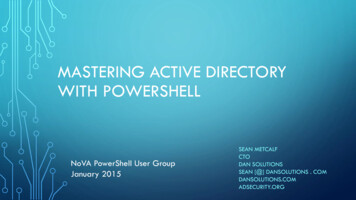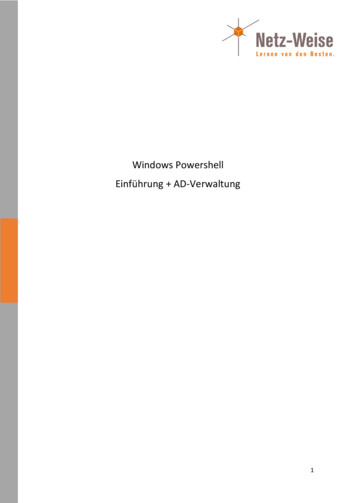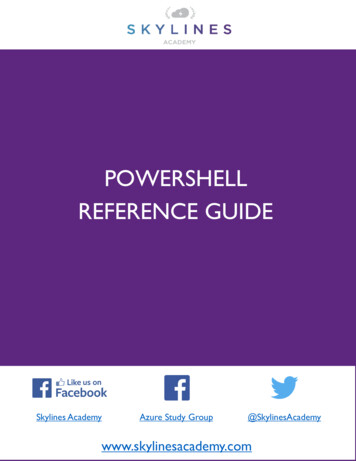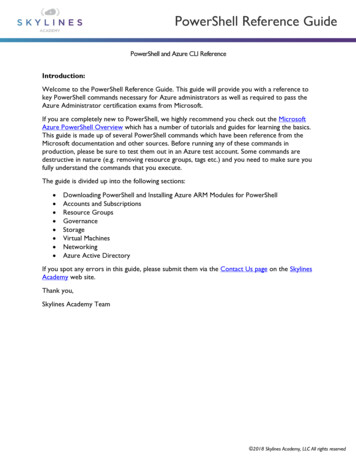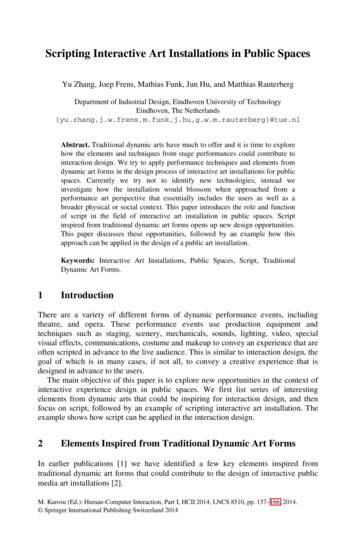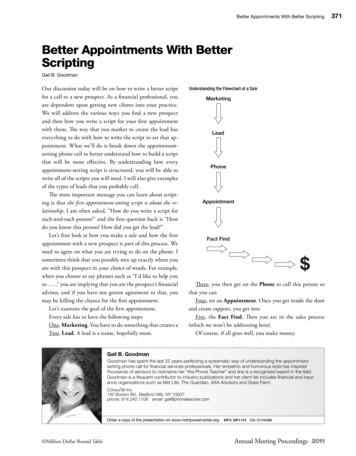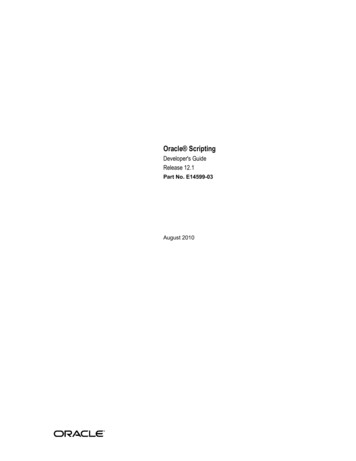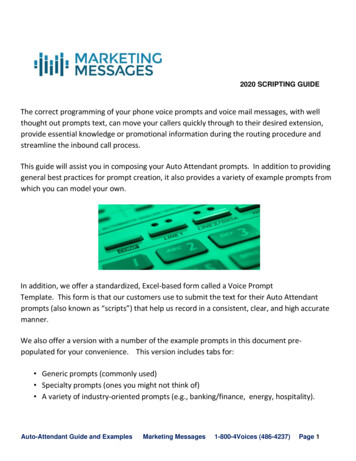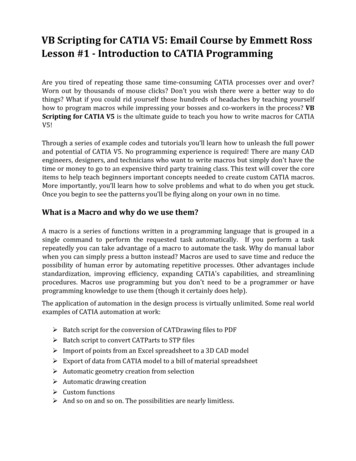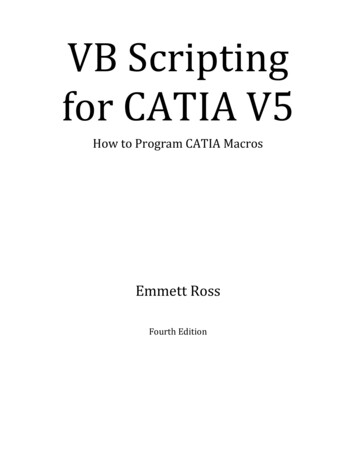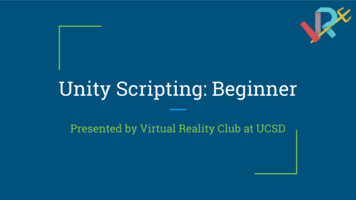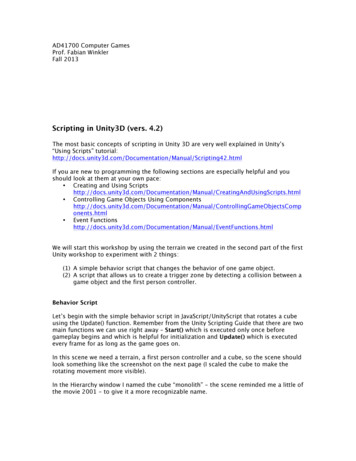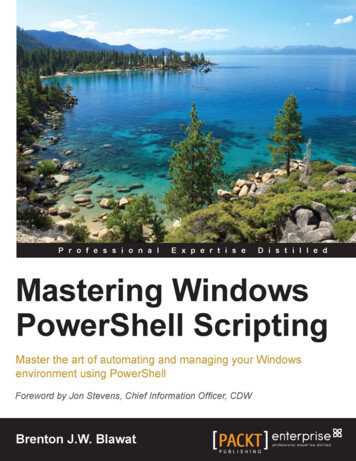
Transcription
Mastering Windows PowerShellScriptingMaster the art of automating and managing yourWindows environment using PowerShellBrenton J.W. Blawatprofessional expertise distilledP U B L I S H I N GBIRMINGHAM - MUMBAI
Mastering Windows PowerShell ScriptingCopyright 2015 Packt PublishingAll rights reserved. No part of this book may be reproduced, stored in a retrievalsystem, or transmitted in any form or by any means, without the prior writtenpermission of the publisher, except in the case of brief quotations embedded incritical articles or reviews.Every effort has been made in the preparation of this book to ensure the accuracyof the information presented. However, the information contained in this book issold without warranty, either express or implied. Neither the author, nor PacktPublishing, and its dealers and distributors will be held liable for any damagescaused or alleged to be caused directly or indirectly by this book.Packt Publishing has endeavored to provide trademark information about all of thecompanies and products mentioned in this book by the appropriate use of capitals.However, Packt Publishing cannot guarantee the accuracy of this information.First published: April 2015Production reference: 1210415Published by Packt Publishing Ltd.Livery Place35 Livery StreetBirmingham B3 2PB, UK.ISBN 978-1-78217-355-7www.packtpub.com
CreditsAuthorBrenton J.W. BlawatReviewersProject CoordinatorMary AlexProofreadersTim AmicoSimran BhogalChristophe CRÉMONSafis EditingTomas RestrepoMaria GouldPaul HindleAcquisition EditorMeeta RajaniIndexerRekha NairContent Development EditorRohit SinghProduction CoordinatorAlwin RoyTechnical EditorTanvi BhattCover WorkAlwin RoyCopy EditorsHiral BhatSonia MathurVikrant PhadkeAlpha Singh
ForewordWe all appreciate a little simplicity when it enters our busy, complicated lives.Technology is no different. In fact, that is what we expect from technology—it shouldsimplify our lives. But it doesn't always work that way.Sometimes technology can introduce vexing problems we don't anticipate.With every version of Microsoft DOS and then Windows, Microsoft includedseparate command-line interface shells. The shell could automate some tasks, butnot all of them. Some tasks had to be accomplished manually, which is antithetical—nearly heretical—to our understanding of technology's role.What should have been simple, automated tasks became slow, frustrating, andmanual chores. That conundrum didn't go unnoticed.Microsoft provided much-needed simplicity when it introduced PowerShell in 2006.Task automation and configuration management eliminated a great deal of timeconsuming manual work. In short, PowerShell was a game changer.PowerShell has solved many of the command-line and scripting issues thatcomplicated our work. It introduced simplicity. It helped organizations become moreagile, more productive, and save money. PowerShell is a powerful tool, and it hasdemonstrated its practical value many times.Despite its utility, though, PowerShell remains a confusing tool to many ITadministrators, and the need for greater clarity remains.It is through this lens that Mr. Brenton Blawat provides an insightful new analysisof PowerShell—a valuable guidebook for those who struggle to understandPowerShell. Others have offered narratives that attempt to explain PowerShell, butthey rarely provide the roadmap, background, or context that administrators need toget from Point A to Point B.
So, this is the right time for a comprehensive new analysis.In general terms, Mr. Blawat's book will help those who struggle to managetheir compute environments. It includes important guidance on programmingin PowerShell, starting with basic concepts and then introducing advancedconfigurations.Mr. Blawat deconstructs and demystifies this programming language, sharing hisintimate knowledge in a format that demonstrates the clarity of thought and prosethat a difficult subject requires. Many authors have attempted this climb, but onlyMr. Blawat has reached the summit. His examination provides relevant informationfor administrators who work with—and sometimes struggle with—PowerShell on adaily basis.As Mr. Blawat explains in the following pages, the rapid adoption of cloud-basedtechnologies paralleled the never-ending need for additional computing power indata centers. This created the need to efficiently build and expand systems withextreme precision. In addition to provisioning the base systems, there was a need todynamically customize these new systems to work in unison with current runningenvironments.This drove the need for the next generation system automation languages that wouldprovide full configuration for systems on the fly. Not only do these automationlanguages greatly reduce time to use, but they also ensure that no mistakes are madeduring the configuration process. All systems are created equally.PowerShell is a .NET-based next generation automation language that provides bothsystems provisioning and management functionality for Windows-based systems.Leveraging command-line like interactions, PowerShell can be compiled into scriptsthat can systematically execute tasks on a system. Not limited to creating newsystems, engineers are leveraging PowerShell to automate mundane tasks so thatthey can focus on other pressing activities in their environments.Microsoft has fully embraced PowerShell in its full software portfolio to offer fullintegration with its products. Not only can you dynamically install the Microsoftsoftware, but you can also fully manage the entire Microsoft software environmentusing PowerShell. PowerShell has also been embraced by third-party manufacturersthrough the integration of PowerShell modules. These modules provide fullmanagement capabilities for products such as network devices, storage subsystems,virtualization guests and hosts, security appliances, and other third-partyapplications.
Like many organizations, CDW has benefitted greatly from PowerShell, so thisbook hits very close to home for me. We use PowerShell scripts to manage customerenvironments in managed services and the installation of management tools.We use Microsoft Orchestrator to provide back-end logic for simple user interfacesfor help desk activities, like user-driven password resets and user-driven softwareinstallations. We also rely on Microsoft Orchestrator to automatically troubleshootand remediate systems.CDW's customers also benefit from PowerShell in myriad ways. We assist a widevariety of Fortune 500 clients to develop PowerShell automation scripts to build newsystems and manage their environments, including health check scripts, systemsdiscovery, and advanced regulatory security analysis.Clearly, PowerShell's incredible utility has made it invaluable to CDW, ourcustomers, and countless organizations across the globe. But understanding all ofits many facets represents a daunting task. Organizations are unable to leveragePowerShell if they don't fully understand its potential.That's where Mr. Blawat excels.Mr. Blawat's comprehensive new work will serve as a reference tool for engineerswho work with Windows by taking the mystery out of common tasks that aren'teasily understood and aren't always intuitive. Diligent readers will no doubt findmany more reasons to give Mr. Blawat's thorough narrative a prominent place ontheir bookshelves.As Mr. Blawat's coworker, I also feel proud that he is sharing his knowledge with theworld—not only so others can benefit from his experience, but so they can see whatthose of us who work with him at CDW witness on a daily basis.PowerShell has proven to be an incredibly useful tool for IT administrators sinceit burst on to the scene. Now there is a book about PowerShell that will prove equallyuseful.Jon StevensChief Information OfficerCDW
About the AuthorBrenton J.W. Blawat is an entrepreneur, strategic technical advisor, author,and senior consultant, who has a passion for the procurement of technology inprofit-based organizations. He is business-centric and technology-minded.Brenton has many years of experience in bridging the gap between technical staffand decision-makers in several organizations. He takes pride in his ability toeffectively communicate with a diverse audience and provide strategic directionfor large and small organizations alike.In 2013, Brenton authored his first book, PowerShell 3.0 WMI Starter, Packt Publishing.This book was designed to be a starter for those interested in manipulating WindowsManagement Instrumentation through the use of PowerShell 3.0. This book isavailable in all popular book stores, including Packt Publishing's website, http://bit.ly/18pcpGK.Brenton currently works at CDW as a senior consulting engineer in strategicsolutions and services. CDW is a leading multibrand technology solutions providerin the fields of business, government, education, and healthcare. A Fortune 500company, it was founded in 1984 and employs approximately 7,200 coworkers.In 2014, the company generated net sales of more than 12.0 billion. For moreinformation about CDW, you can visit www.CDW.com.I would like to thank the foreword coordination team, Mary Viola,Scott Thomas, Jimmy Thomson, Brandon King, Sondra Ragusin,Meredith Braselman, and Bill Glanz. I would like to dedicate thisbook to my beautiful nieces, Caliett and Evie.
About the ReviewersTim Amico is a consulting engineer at CDW, who specializes in ConfigurationManager and Operating System Deployment. He started his career in IT back in1998, when he worked as a configuration tech for CompuCom, learning about whatis required to become an IT professional. Since then, he has climbed the ladderfrom hardware field support and software deployment support to his current role(for the last 10 years) as an IT consultant, designing and implementing endpointand mobility management solutions. Apart from Configuration Manager and OSD,Tim also has experience in PowerShell, BitLocker drive encryption deployments,Intel vPro provisioning and use case design, Active Directory (both in Azure andWindows Server), SQL design and reporting, PKI design, and Microsoft Intune.Christophe CRÉMON is a SharePoint infrastructure architect, with 10 yearsof experience in information technology, especially Microsoft. He has been usingPowerShell since 2008, and has published useful scripts and modules for ITAdministrators at powershell.codeplex.com. He has a personal website at www.christophecremon.com.Tomas Restrepo has been writing software for over 10 years, starting with C/C and eventually moving to the .NET platform. He currently spends most of his timehelping other developers solve complex problems and troubleshooting applicationperformance and scalability issues.
www.PacktPub.comSupport files, eBooks, discount offers, and moreFor support files and downloads related to your book, please visit www.PacktPub.com.Did you know that Packt offers eBook versions of every book published, with PDF and ePubfiles available? You can upgrade to the eBook version at www.PacktPub.com and as a printbook customer, you are entitled to a discount on the eBook copy. Get in touch with us atservice@packtpub.com for more details.At www.PacktPub.com, you can also read a collection of free technical articles, sign up for arange of free newsletters and receive exclusive discounts and offers on Packt books and ion/packtlibDo you need instant solutions to your IT questions? PacktLib is Packt's online digital booklibrary. Here, you can search, access, and read Packt's entire library of books.Why subscribe? Fully searchable across every book published by Packt Copy and paste, print, and bookmark content On demand and accessible via a web browserFree access for Packt account holdersIf you have an account with Packt at www.PacktPub.com, you can use this to accessPacktLib today and view 9 entirely free books. Simply use your login credentials forimmediate access.Instant updates on new Packt booksGet notified! Find out when new books are published by following @PacktEnterprise onTwitter or the Packt Enterprise Facebook page.
Table of ContentsPrefaceChapter 1: Variables, Arrays, and HashesVariablesObjects stored in variablesArraysSingle-dimension arraysJagged arraysUpdating array valuesHashesDeciding the best container for your scriptsSummaryChapter 2: Data Parsing and ManipulationString manipulationReplacing and splitting stringsCounting and trimming stringsThe Trim methodThe Substring methodThe string true and false methodsNumber manipulation and parsingFormatting numbersFormatting bytesDate and time manipulationForcing data typesPiping 52627303234
Table of ContentsChapter 3: Comparison Operators35Chapter 4: Functions, Switches, and Loops Structures45Chapter 5: Regular Expressions65Chapter 6: Error and Exception Handling and Testing Code87Comparison operator basicsEqual and not equal comparisonGreater than and less than comparisonContains, like, and match operatorsAnd / OR comparison operatorsBest practices for comparison operatorsSummaryFunctionsLooping structuresSwitchesCombining the use of functions, switches, and loopsBest practices for functions, switches, and loopsBest practices for functionsBest practices for looping structures and switchesSummaryGetting started with regular expressionsRegular expression grouping constructs and rangesRegular expression quantifiersRegular expression anchorsRegular expressions examplesSummaryError and exception handling – parametersError and exception handling – Try/CatchError and exception handling –Try/Catch with parametersError and exception handling – legacy exception handlingMethodologies for testing codeTesting the –WhatIf argumentTesting the frequencyHit testing containersDon't test in productionSummaryChapter 7: Session-based Remote ManagementUtilizing CIM sessionsCreating a sessionCreating a session with session options[ ii 39696979899101103104107109
Table of ContentsUsing sessions for remote managementRemoving sessionsSummary111113114Chapter 8: Managing Files, Folders, and Registry Items117Chapter 9: File, Folder, and Registry Attributes,ACLs, and Properties137Chapter 10: Windows Management Instrumentation159Chapter 11: XML Manipulation177Registry providerCreating files, folders, and registry items with PowerShellAdding named values to registry keysVerifying files, folders, and registry itemsCopying and moving files and foldersRenaming files, folders, registry keys, and named valuesDeleting files, folders, registry keys, and named valuesSummaryRetrieving attributes and propertiesViewing file and folder extended attributesSetting the mode and extended file and folder attributesManaging file, folder, and registry permissionsCopying access control listsAdding and removing ACL rulesSummaryWMI structureUsing WMI objectsSearching for WMI classesCreating, modifying, and removing WMI property instancesCreating property instancesModifying property instancesRemoving property instancesInvoking WMI class methodsSummaryXML file structureReading XML filesAdding XML contentModifying XML contentRemoving XML 2193[ iii ]
Table of ContentsChapter 12: Managing Microsoft Systems with PowerShell195Chapter 13: Automation of the Environment223Chapter 14: Script Creation Best Practices and Conclusion241Index253Managing local users and groupsManaging local usersManaging local groupsQuerying for local users and groupsManaging Windows servicesManaging Windows processesInstalling Windows features and rolesSummaryInvoking programs for automationUsing desired state configurationAuthoring phaseStaging and remediation phaseDetecting and restoring drifting configurationsSummaryBest practices for script management# commenting headersCommenting codeBest practices for script creationScript structureOther important best practices for script creationControlling source filesBest practices for software automationSummaryMastering Windows PowerShell Scripting – conclusionStaying connected with the author[ iv 43245245246248249250251251
PrefacePowerShell is a network scripting language that provides a set of tools to administerMicrosoft products. While PowerShell is based on command-line interactions, it ismuch more powerful than what the standard command line offers. It has built-insections of code called cmdlets. They simplify functions that you may need to performon a system. Using cmdlets greatly reduces the number of lines of code that arerequired to perform actions, compared to other scripting languages, such as VBScript.PowerShell is based on the verb-noun naming convention, which allows scriptersto declare an action followed by an object to configure. For example, the get-servicecmdlet easily designates that you are getting a Windows service. This literal namingconvention helps readers quickly learn how to program in PowerShell, as the actionsare easily remembered.Community support for PowerShell has grown astronomically. Not only havelarge companies adopted PowerShell in their environments, but universities arealso regularly teaching PowerShell courses to their students. PowerShell's featureset keeps growing with every release of the product. It is conceivable in the nearfuture that you will be able to fully automate the configuration of every componentin a data center. This will remove the needs of multiple engineering specialiststo provision networking, storage, firewalls, operating systems builds, and highavailability configurations. It will all be done via PowerShell scripting and thesystems will be able to be configured using a singular network language.This book provides a strong foundation for learning PowerShell using real-worldscenarios. You will not only be able to quickly learn how to program in thislanguage, but also be able to produce scripts that you can use in your existingenvironments. This book will also be a great reference book for you to look backon and revisit as you are coding. It will provide the proper syntax and show yousuccessful ways to implement your code. When you are done with reading this book,you will be well on your way to "mastering PowerShell"![v]
PrefaceWhat this book coversChapter 1, Variables, Arrays, and Hashes, explores the different data and objectcontainers that you can use in PowerShell. These containers include variables,arrays, and hashes. This chapter provides examples on how to use thesecontainers to store objects.Chapter 2, Data Parsing and Manipulation, dives into the different data types andhow to manipulate them in your scripts. These data type examples include strings,integers, dates, XML, and many more.Chapter 3, Comparison Operators, evaluates multiple comparison operators anddisplays how to use each of these comparison operators. This chapter also displayshow to leverage implied true and false comparison operators.Chapter 4, Functions, Switches, and Loops Structures, displays the use of different datastructures to perform repeatable actions. It provides examples on how to parse largearrays of data through looping structures and how to include overload parameters inthese structures.Chapter 5, Regular Expressions, explores PowerShell's implementation of regularexpressions. It evaluates the built-in comparison operators that provide expressionvalidation and how to create complex expressions.Chapter 6, Error and Exception Handling and Testing Code, shows you how to createcode in a robust manner to avoid exceptions during execution. This chapter explainsvarious built-in error and exception handling techniques, as well as support forlegacy systems that don't support PowerShell cmdlet triggers. It also explains thedifferent items to be aware of during the testing cycle o
for help desk activities, like user-driven password resets and user-driven software installations. We also rely on Microsoft Orchestrator to automatically troubleshoot and remediate systems. CDW's customers also
